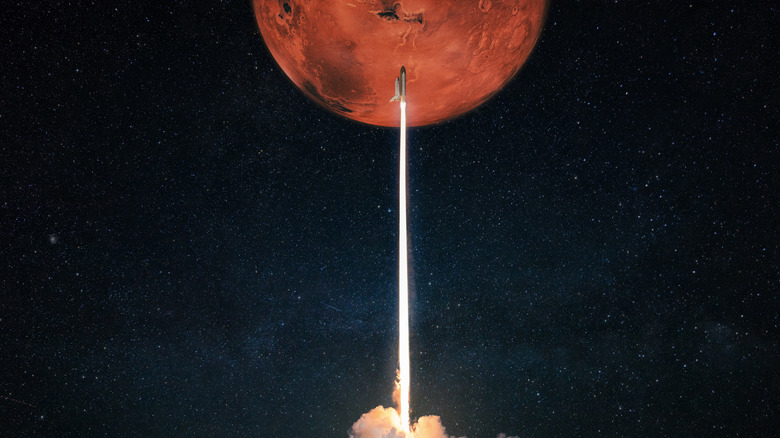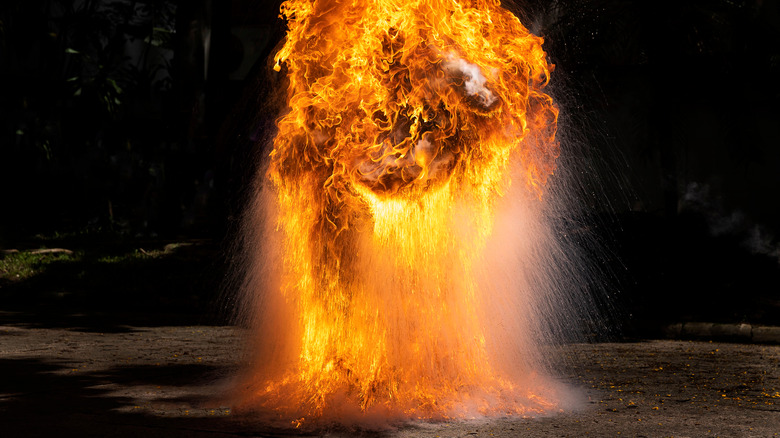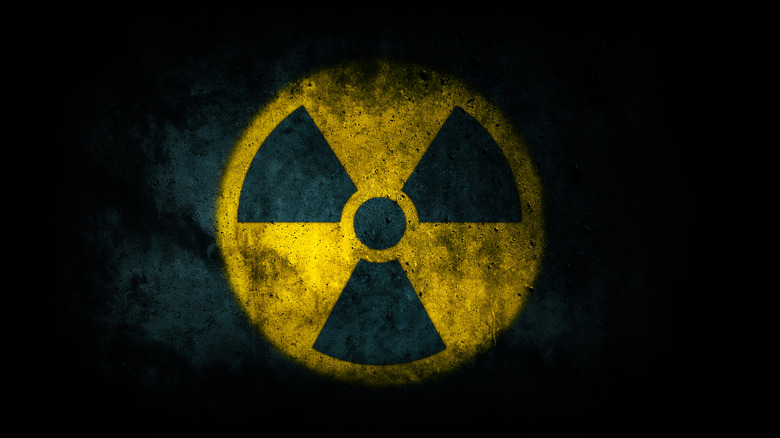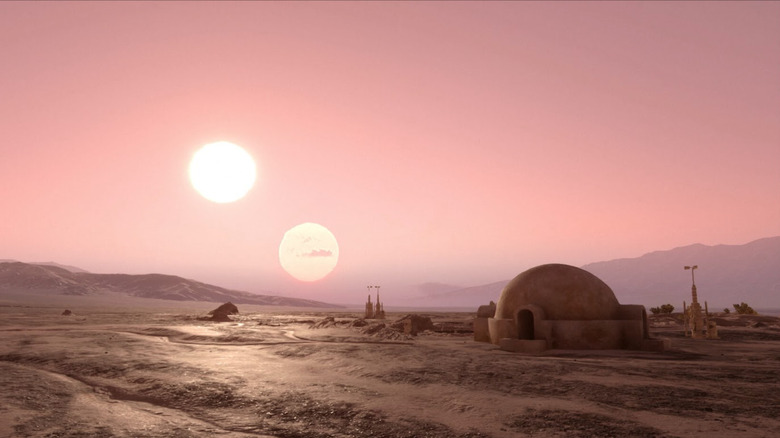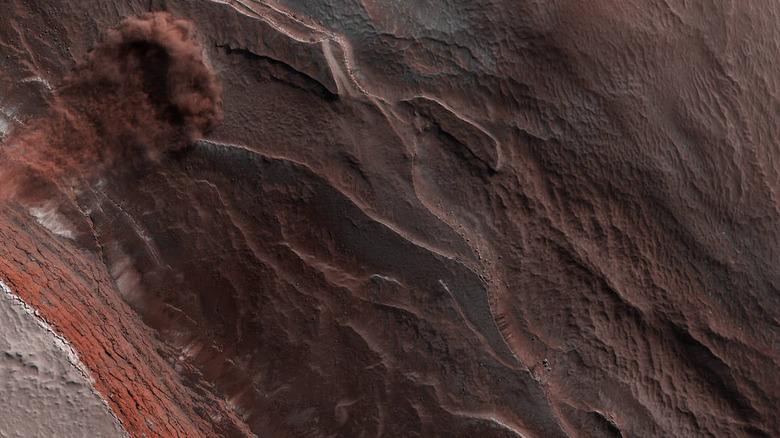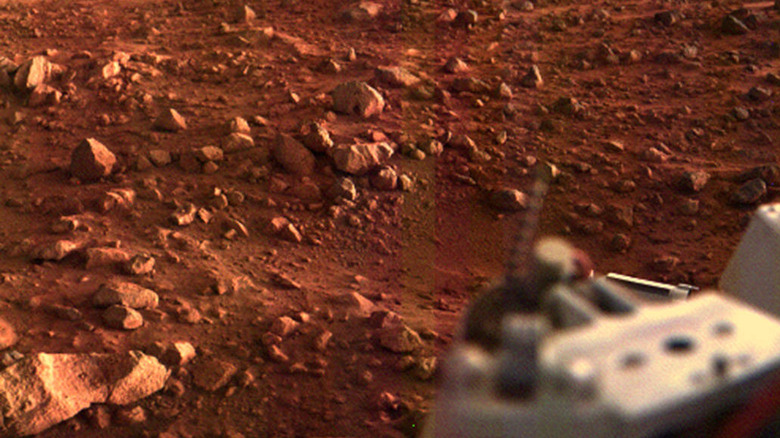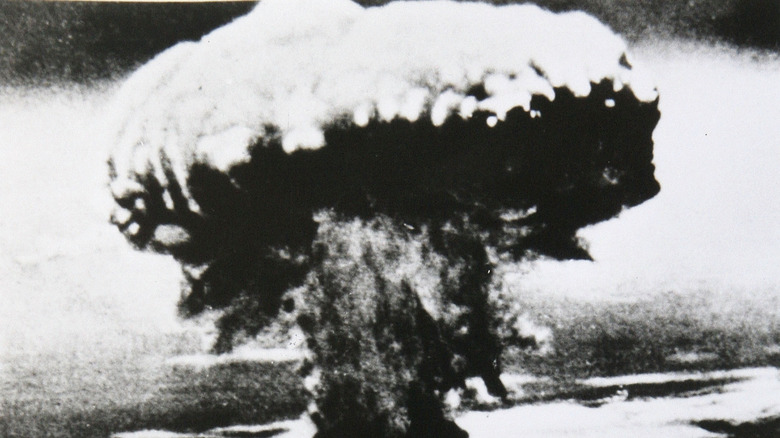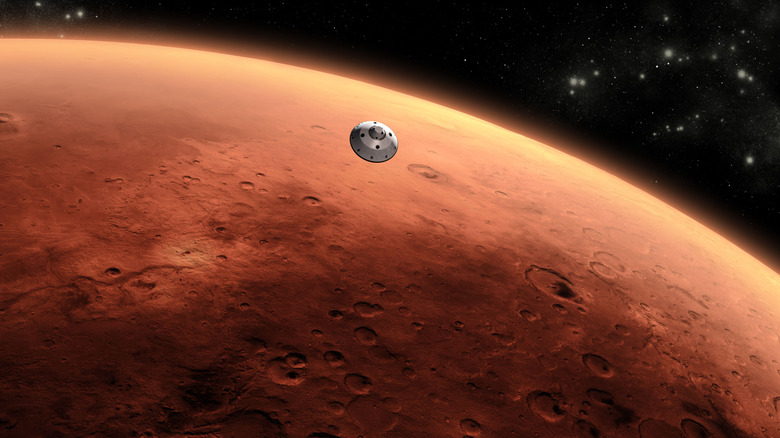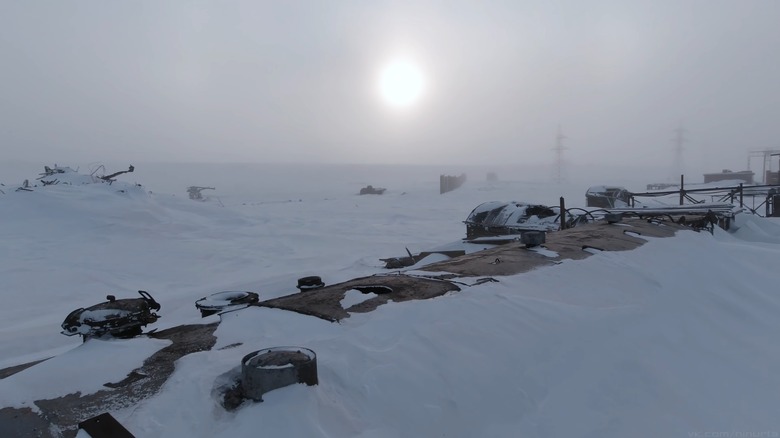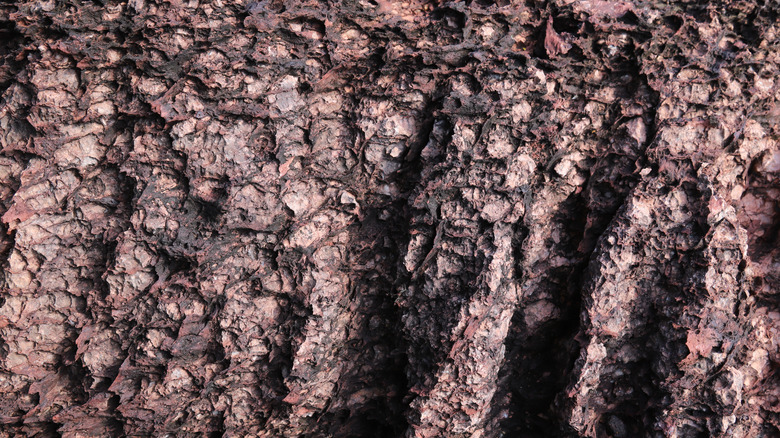What Would Happen If We Nuked Mars?
Here's the thing about Elon Musk. If you ask him something, don't expect mundane answers. The SpaceX and Tesla futuretech mogul blew open the idea of terraforming Mars in a 2015 interview with Stephen Colbert on "The Late Show With Stephen Colbert." When a mystified Colbert asked him how human beings would ever be able to survive what is essentially a radiation-blasted desert that's been stuck in the freezer for several billion years, Musk humored him.
"It's a fixer-upper of a planet," he admitted, adding that anyone brave enough to inhabit that wasteland of red dust would probably have to live in some sort of pods for a while. That was when Colbert needed to know how exactly it could be done. Musk tantalized him with the prospect of a fast way and a slow way, and of course, you can guess what Colbert wanted to find out.
"The fast [way] is [to] drop nuclear weapons over the poles," Musk replied.
Colbert half-jokingly called him supervillain. What kind of Thanos or Lex Luthor would go bombing an alien planet out of nowhere, and why? The short answer is heat. Bomb the poles, send temperatures soaring, melt ice into water, heat the planet. But would it work? This is where things gets complicated, which could possibly explain the underlying reason that video went viral.
How to nuke Mars
At least according to Elon Musk, the quickest way to start terraforming Mars would be slamming its north and south pole with hydrogen bombs to melt all the ice. There is some logical sense to this. As NBC News notes, the Martian poles are glazed over with water and carbon dioxide ice. Not that Mars has never seen liquid water in its life. According to NASA, Jezero Crater was recently proven to have once been an enormous prehistoric lake. The Perseverance rover is searching for rocks that the space agency will someday fly to Earth.
Say you did hurl mammoth H-bombs at poles of Mars. Water ice would melt. Carbon dioxide ice sublimates, meaning it transitions from a solid to vapor state with no liquid phase, as the United States Geological Survey details. CO2 is also a greenhouse gas that, according to the EPA, traps heat in the atmosphere. Boosting CO2 emissions could potentially raise the average Martian daytime temperature of -81 degrees Fahrenheit and even make it warm enough.
Mars barely has an atmosphere now, but NBC News noted that once bombs were detonated and water vapor and carbon dioxide were unleashed into the sky, that would create an atmosphere that would eventually absorb solar energy and consequently raise the thermostat.
New technology would be needed
"Let's be blunt," physicist Michio Kaku told Big Think when asked his opinion on how the Red Planet could be even remotely habitable. "It will take centuries to terraform Mars."
Kaku highlighted that Mars is huge, about half the size of our own planet. That means you're going to need a gargantuan amount of firepower. Space nukes sound next-level — but while H-bomb tech has been around for a while, it's nowhere near Martian ice annihilation yet. An estimate from a 2018 Stanford University study, which investigated how much of Elon Musk's fantasy is actually reality, reveals that the power of all the nuclear weapons on Earth still doesn't come out to the amount of energy needed to morph all the CO2 ice on Mars into vapor.
How much power would actually be needed? Popular Mechanics says Musk would need at least 10,000 of today's most advanced nukes unless they were seriously upgraded. Then you would have to actually launch the things into space. After that, you would have to keep them raining down on the poles to set off the melt and vaporization that could make Mars more Earthlike. In a statement to news agency TASS, the Russian space agency, Roscosmos, said that "humanity does not have the capacity to influence in any tangible way Mars' ... climate."
The explosions would look like artificial suns
Elon Musk evidently realized that he needed to explain more about how H-bombs could turn Mars into another Earth. At an event in Times Square, not long after the infamous Stephen Colbert interview, he proposed detonating these bombs over the Martian poles every day to push the melting and vaporizing of water ice and CO2 ice, fast-forwarding the terraforming process. These "suns" really didn't seem all that alien to him because they would be so high. "They're really above the planet, they're not on the planet," he said at the event (via The Verge). "A lot of people don't appreciate that our sun is a large fusion explosion."
He's right about that one. As Western Washington University explains, the sun uses nuclear fusion in its depths to produce the tremendous amounts of heat and light that it does, smashing together nuclei of hydrogen atoms into helium nucleus. It will continue to fuse hydrogen atoms into helium until it finally burns out. As The Verge reported, the explosion of a nuke over the poles of Mars every few seconds (yes, seconds) would appear like a pulsating sun.
If the sun sends radiation through space as it goes through the fusion process, does that mean Mars would be showered with even more radiation as it undergoes Musk's terraforming process? According to News 18, he doesn't think this is going to be a problem because the H-bombs would explode in space, not anywhere near the surface.
Ice would melt into tons of water
While Earthling tech is not going to be able to morph Mars into a habitable planet for a while, say it could. There is no doubt nuclear explosions would generate enough heat to melt or vaporize tons of water and CO2 ice.
Melted water ice alone would provide drinkable water that, according to MIT scientists thinking about doing the same on the moon in MIT Technology Review, could also be separated into its hydrogen and oxygen components for breathable air and even rocket fuel. You just have to isolate the H2 and O of H2O and turn them into their liquid form. This propellant would be produced right there on the planet, so it would not only be free but wouldn't risk weighing down spaceships headed (at minimum) 34 million miles to Mars. That is about how far Earth is from the Red Planet when its orbit gets closest to Earth, according to NASA — and it's rare.
If Jezero Crater was once a crater lake, and Mars is suspected to have once had more lakes and rivers on its now-parched surface (via National Geographic), it could end up flowing with liquid water again after being bombarded by tens of thousands of nukes. Something that might offer promise to a future nuclear terraforming plan is that, as scientist Philip Ball observes in a study published in Nature, the ice caps on the Martian poles are already evaporating and triggering a greenhouse effect. Ball admits that nobody really knows the reason behind this.
Things could start growing in that red dust
Imagine Elon Musk's nuke plan really does terraform Mars. Life needs water to survive, so there would end up being plenty of that around. But what about food?
Forget flying in food from Earth, because that would be a heavy and ridiculously expensive payload, which would also burn an unearthly amount of fuel. Growing things that can survive the terraformed Martian climate would be the way to go. Recent experiments using simulated Martian regolith (soil) have shown this is a possibility. With water and sunlight, which was regulated to mimic conditions on Mars, it is possible for some types of plants to thrive over there. According to Smithsonian Magazine, this is how Heinz made "Martian ketchup" right here on Earth.
In what they call "the first large-scale controlled experiment to investigate the possibility of growing plants in Mars and moon soil simulants," a group of researchers who published a study in PLOS ONE found that there are some plant species that can thrive in both lunar and Martian regolith. These included tomatoes, mustard, and wheat. Another study, published in Frontiers in Astronomy and Space Sciences, also suggests recycling organic waste and combining them with minerals already found on Mars to create substances that would be ideal for plant growth and sustainable food production.
Not only could food be grown on Mars, but plants would breathe out more oxygen. Space farming could become a thing.
Nuking the planet wouldn't warm things up right away
According to NASA, to terraform a planet that is basically the frozen version of Arrakis in Frank Herbert's "Dune," you need a runaway greenhouse effect. This happens when a planet has so much solar energy trapped in the atmosphere — and this energy means heat — that it can't get rid of it. Temperatures will rise faster as the surface gets hotter. While this is a threat to Earth, it could make Mars tolerable, but not so fast.
Nuking the planet would not instantly terraform it. Maybe Elon Musk wants instant gratification, but it's not about to happen. Those H-bombs might not even do enough. In one study published in Nature, a team of researchers argue there is not enough CO2 on Mars for a greenhouse effect of the magnitude that would be required to terraform the planet. Even all the planet's estimated amount of CO2 (how much is actually there remains unknown) is unlikely to be enough, according to the University of Melbourne. If all the carbon dioxide Mars is thought to have was released, temperatures would only end up about 50 degrees Fahrenheit warmer. You would still dealing with a daytime high of negative 30-something.
In the Nature study, the research team goes on to say that data beamed back to Earth from spacecraft such as NASA's Mars Reconnaissance Orbiter has shown that not only would there be a CO2 deficit in an attempt to terraform Mars, but some of the gas is impossible to get to.
So why don't we use something even more powerful than H-bombs?
Fallout, says the University of Melbourne, would be a major consequence of using nuclear bombs. At least hydrogen bombs leave behind minimal fallout in their wake. According to the World Nuclear Association, the atomic bombs dropped on Hiroshima and Nagasaki during World War II exploded into mushroom clouds of uranium and plutonium. You couldn't exactly live in such an environment — next to killing about 100,000 people when they first exploded, those bombs have also caused hundreds of hundreds of cases of cancer, some lethal.
Bombing is not the only hypothetical way to terraform Mars. As Elon Musk told Stephen Colbert, it would be the fastest, but back up for a moment. NASA suggests perfluorocarbons (PFCs) because they can warm an atmosphere much faster than CO2 and last much longer. Whether they would harm humans and other life-forms is still debatable. NASA insists they wouldn't. While the CDC says that no one really knows whether low levels of these chemicals would have any adverse effects on us or anything else, they also tread cautiously because lab experiments have shown that high levels of some types of PFCs have harmed animals and could have potential health consequences for us.
The University of Melbourne has a more sci-fi suggestion — a protective silica aerogel whose insulation powers would trap warmth and ward off killer radiation. Aerogels look like gelatin but are deceptively strong — a plus for living on Mars.
What about an atmosphere?
Mars has next to no atmosphere — the sun devoured it over billions of years. NASA found out this is what happened when solar wind and radiation kept gnawing away at the planet. As the University of Arizona details, it is also missing an ozone layer, which the EPA explains is a built-in shield that absorbs radiation. There's also no magnetic field, which offers more protection from forces that would otherwise destroy our atmosphere and leave Earth as desolate as Mars.
If enough greenhouse gases were produced by the nuclear blasts that would keep slamming the poles of Mars over and over again, the atmosphere created by that CO2 and water vapor could act as one enormous UV shield, as per NASA. The downside of this is that these gases would need to work overtime. There is a way around this with PFCs. If the amounts hypothetically needed to terraform Mars would not cause any harm to humans, they are not prone to breaking down anywhere near as fast as water vapor and carbon dioxide.
However, if there really isn't enough CO2 on Mars to create a protective atmosphere, humans will need an assist. Say the time comes when the planet is terraformed as much as possible, and humans get there. Not enough atmosphere? This is where the silica aerogels could potentially create livable Martian habitats by blocking harmful radiation, as per the University of Melbourne.
Massive explosions could bring on a nuclear winter
Nuking anything has its risks, especially an entire planet. Nervous scientists reacted to Elon Musk's terraforming plan with trepidation when interviewed by US News. "There are so many things that could go wrong here it is difficult to know where to start," said climate scientist Michael Mann of Penn State University.
Further, scientist Jason Smerdon also told US News that he "would be cautious about our ability to terraform and manage another planet when we struggle so mightily with the practical and preventative measures that are vitally needed to maintain our own."
Maybe there would be minimal fallout from hydrogen bombs compared to atomic bombs, but so much bombing could result in a nuclear winter, as Mann notes. So much debris from constant explosions would end up clouding the Martian sky and preventing sunlight from coming through. That might not seem so negative at first, since the sun did obliterate most of the atmosphere Mars is thought to have had, but the planet would get even colder than it already is.
It does't help knowing that the dinosaurs were obliterated by a nuclear winter 65 million years ago, as per the American Institute of Physics. When that deadly asteroid struck, it kicked up immense amounts of debris and literally shook the Earth. Volcanoes were erupting and sending clouds of smoke and ash into the sky. Lack of sunlight and heat meant plants had a hard time photosynthesizing, and whatever ate those plants would starve, and ... you know where this is going.
If anything lives (or lived) on Mars, all signs of it would probably be annihilated
Mars only looks barren. Whether anything is crawling around over there, or if it was ever inhabited to begin with, is still unknown. There might not be any intelligent Martian beings in the form of cartoonish little green men, but there is still a chance that there could be alien microbes on Mars, deep beneath the sun-blasted surface where there is still water trapped in the soil.
Scientists do know there was once liquid water on the Martian surface, as per National Geographic. That is why Perseverance is scouring Jezero crater for samples that might be hiding fossilized microbes — if water on Earth means life, it might have also meant life for water on Mars. Debris and radiation from all that bombing could either obscure fossils or eliminate any microbial life that could have sought shelter from the brutal sun deep below the surface. With that much destruction, even from above, it would be hard to know whether there is or was anything alive on Mars.
There is also concern about humans colonizing Mars even if it can be terraformed. As astronomer David Weintraub of Vanderbilt University told The Conversation, "a very real possibility exists that the first human steps on the Martian surface will lead to a collision between terrestrial life and biota native to Mars." It's an ethical dilemma.
Even if we succeeded, we wouldn't be going there anytime soon
Make no mistake. Mars would still be plagued by unearthly cold right after the nuking (via the University of Melbourne), and there is no way humans could just jet over there on a spaceship and live with an H-bomb exploding every other second. Even if as much water vapor and CO2 as possible are released by nuking the poles, and PFCs (if they are proven not to harm us or mutate our genes) fill in where there are deficits, the greenhouse effect will take a while to kick in, as per NBC. Michio Kaku meant it when he said that humanity would have to wait centuries to see a terraformed Planet B, as per Big Think.
Another team of scientists who published a study in Nature Geoscience figured out how carbon dioxide, water vapor, and a smaller amount of molecular hydrogen could have made young Mars warm enough for its water not to freeze over. Spoiler: It took eons. Earth went through a similar phase way back, except it managed to hold on to its atmosphere. If greenhouse gases took forever to warm up a young Earth and Mars, people shouldn't expect the Red Planet to reach Earthlike temperatures right away even with 10,000 nukes. Elon Musk would have to wait decades to even start to see any results from this endeavor.
"It's a clever idea in principle," Michael Shara, astrophysics curator for the American Museum of Natural History, told NBC News. "Whether it would really work, I don't think anyone has worked up the physics in enough detail to say it would."
